Where the Wild Things Are
Dundee Contemporary Arts
10th June -13th August 2006
While crossing the border between human and animal kingdoms, DCA superficially mimics the wares of the watercolour-challenged currently emerging from hibernation to display their plumage at a myriad of summer shows. The ambience of Sendak’s children’s book wafts through many of the small paintings and drawings that form the bulk of the exhibition, a predeliction for fairy-tale gore that unites The Lonely Piper’s folklore with the gothic phantasmagoria of Duncan Marquis and the ominous Boy’s Own pleasures of Christopher Orr. Marquis’ uses wispy pencil strokes to create ghoulish yet highly seductive images of eyeless fraulines and eerie bed chambers. The Lonely Piper’s The water of life, a spirit not to be exorcised (2006) bears the legend ‘THE HAUNTED DRAM’ woven in a spider’s web, recounting an old tale of a whisky that possesses the drinker.
The pitch-perfect parlour paintings are punctuated by a series of sound-based works, the most prominent being Dave Allen’s The Mirrored Catalogue d’Oiseaux (2002/2003), a large aviary populated by starlings exposed to the piano music of Olivier Messiaen. The piano pieces aren’t mimetic, based as they are on a complex process of translation and idealisation. The enchanted spiegelglass is disingenuous, the reverse of what it purports to represent. Rather than being a mirroring process then, Allen’s ornithological installation shatters the illusion of ‘truth to nature’. Messiaen’s music involved the transformation of the songs he notated; are the mockingbirds capable of the same feat? If they copy Messiaen, are they being truly ‘natural’ in their behaviour? Marcus Coates’ A Guide to the British Non Passerines (2001), a DVD featuring the artist mimicking birdsongs, adapts Messiaen’s tactics to different effect. Coates has carefully sped-up his slow worbells into twitters. Twitching as fast as a bird, it’s obvious that he has resorted to special effects, but this only adds to his humility and the delight of the illusion. A tree too far, Henrik Hakansson’s For A Day Like Today (Spiritual Tree No. 2 Thailand) (2004), a tree wired to amplify the sound of crickets, comes across as all too earnest, obvious and illustrative in this convivial company..
No natural history themed exhibition would be complete without a taxonomy-based project. Ilana Halperin fills the gap with Emergent Landmass (a chronicle of disappearance) (2006-7) a book accompanied by a series of drawings and mineral samples that represent the sudden appearance and disappearance of Ferdinandea, a volcanic island in the Mediteranean. In some ways this functions as a conceit for a series of seductive drawings which give substance to a curiously volatile geological plateau. Halperin’s invocation of the romantic idea that nature and beauty are inseperable from change is echoed in Melanie Carvalho’s Expedition (2003-2005) an even more varied smogasboard of watercolours, oil paintings, drawings, botanical drawings, photographs, collages, maps, books and Super 8. All document her journey around the West coast of Scotland in search of ‘alien’ flora and fauna supported by the Gulf Stream. The result is a map of Scotland that doesn’t square with Romantic representations of mountains and heather. For Carvalho, nature’s adaptability is a metaphor for human diaspora, a lens through which to examine Scotland’s changing demographic. Because of its all-inclusiveness, the installation doesn’t make a very convincing pseudo-museological presentation; the travelogue translates much better into book form.
Wild Things has its compost. Diana Thater’s Perfect Devotion Two (2005), a film of captive tigers behaving like domestic cats, makes a very blunt connection with the theme of mediated nature. The exhibition is tamest where it sticks to such highways and is most ferile, where, like Marquiss’ Roggenwolf (2005) DVD, it strays off into the Forests of Spinal Tap.


